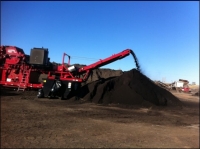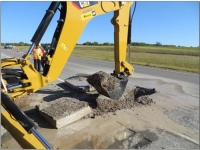Sponsor: Oklahoma Department of Transportation and Federal Highway Administration (ODOT SPR Item Number 2245).
Project Team: Rouzbeh Ghabchi, Musharraf Zaman, Manik Barman, Dharamveer Singh and David L. Boeck
Project Period: October 2012- January 2015
Rising oil and gas prices spurs development of methods and technologies for reducing fuel consumption and increased use of recycled materials. With increased environmental awareness, usr of reclaimed asphalt pavement (RAP) and reclaimed asphalt shingles (RAS) in pavements have been gaining momentum nationally and globally. However, despite their advantages, there are national concerns associated with fatigue and low-temperature cracking potential of pavements when containing increased amounts of RAS and RAP. Therefore, this study was undertaken to evaluate the fatigue performance of hot-mix asphalt (HMA) containing RAS and RAP. Specifically, changes in fatigue resistance and cycles to fatigue failure with changes in the amount of RAS and RAP were examined using both flexural fatigue (four-point beam) and axial fatigue (cyclic direct tension) tests on laboratory compacted specimens. Effect of virgin binder grade on the fatigue performance was also examined. In addition, the effect of RAS and RAP in HMA on its creep compliance and dynamic modulus was investigated. These properties are used in the evaluation of fatigue resistance based on the axial cyclic direct tension test. For this purpose, eight fine surface course mixes (S4) with different types of asphalt binders (i.e., PG 64-22 OK and PG 70-28 OK) containing different amounts of RAS and RAP were designed and tested in the laboratory. The amount of RAS and RAP in HMA mixes varied, but the total amount of replaced binder was kept within certain specifications (i.e., RAP and/or RAS limited to 30% binder replacement). It was concluded that the fatigue life of asphalt mixes with a PG 64-22 OK binder increased with use of RAP or a blend of RAP and RAS. Using a blend of 5% RAP and 5% RAS in a mix led to the maximum increase in fatigue life. However, it was observed that the fatigue life of the mix decreased when 6% RAS was used compared to that of virgin mix with the same type of asphalt binder (PG 64-22). Also, it was found that when a PG 70-28 OK asphalt binder was used, use of RAP and/or RAS in a mix resulted in a decrease in fatigue life. Using 6% RAS resulted in the maximum decrease in fatigue life, compared to that of virgin mix with the same type of asphalt binder (PG 70-28 OK). Use of a polymer-modified asphalt binder (PG 70-28 OK) was found to be an effective way to increase the fatigue life of virgin mixes. More specifically, if RAP and/or RAS was used, fatigue life was a concern. Furthermore, it was concluded that high coefficient of variation values of the cycles to failure found for four-point beam fatigue test show that the repeatability of this method was not very good. The dynamic modulus and creep compliance test results revealed that addition of RAP and/or RAS to asphalt mixes increased their stiffness, for cases in which PG 64-22 OK or PG 70-28 OK asphalt binders were used. This may result in a better rutting performance, but may lead to a mix with a higher low-temperature cracking potential versus the virgin mixes. Finally, it was found that indirect tensile strength (IDT) of the asphalt mixes increased with use of RAP and/or RAS compared to those of virgin mixes. Use of 6% RAS resulted in the maximum increase in IDT values. Also, a comprehensive survey was conducted among the state departments of transportation for gathering data on the current practices including the methods and specifications associated with the use of RAS and RAP in pavements. The results from this study can be used to develop/update guidelines/special provisions for design of HMA containing RAP and RAS in Oklahoma.



